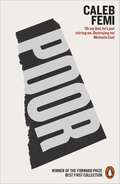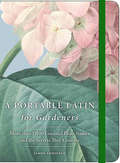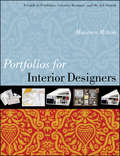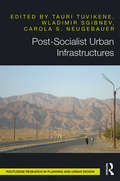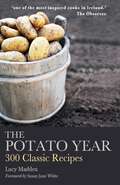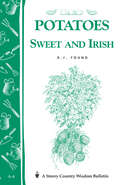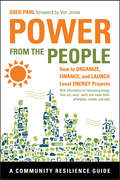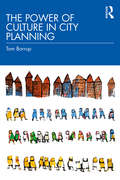- Table View
- List View
Poor
by Caleb Femi'An urban romantic ... powerful' Dazed & Confused 'A poet of truth and rage, heartbreak and joy' Max PorterWhat is it like to grow up in a place where the same police officer who told your primary school class they were special stops and searches you at 13 because 'you fit the description of a man' - and where it is possible to walk two and a half miles through an estate of 1,444 homes without ever touching the ground?In Poor, Caleb Femi combines poetry and original photography to explore the trials, tribulations, dreams and joys of young Black boys in twenty-first century Peckham. He contemplates the ways in which they are informed by the built environment of concrete walls and gentrifying neighbourhoods that form their stage, writes a coded, near-mythical history of the personalities and sagas of his South London youth, and pays tribute to the rappers and artists who spoke to their lives.Above all, this is a tribute to the world that shaped a poet, and to the people forging difficult lives and finding magic within it. As Femi writes in one of the final poems of this book: 'I have never loved anything the way I love the endz.'
Poppy (large print)
by RnibThere is flower on the left and a flower bud on the right of the page. There is a locator dot shown, which will be at the top left of the page when the image is the correct way up. The image is surrounded by a dashed image border. The poppy flower head is in the top left of the page. It has two outer overlapping petals and two inner overlapping petals. In the middle of the flower head are stamens radiating out from the centre. The inner petal on the right has a black patch at its base. The other three petals will have a similar patch but they are not shown. The flower stem goes down the page to the bottom of the image. In the bottom centre of the page is a single leaf mainly to the right of the stem. The base of the leaf at the bottom is in front of the stem so a short section of stem is hidden. A second stem comes from the bottom right of the page and goes up to the right centre of the page. The stem curls left and down at the top, ending in a rounded hairy flower bud.
Poppy (UEB contracted)
by RnibThere is flower on the left and a flower bud on the right of the page. There is a locator dot shown, which will be at the top left of the page when the image is the correct way up. The image is surrounded by a dashed image border. The poppy flower head is in the top left of the page. It has two outer overlapping petals and two inner overlapping petals. In the middle of the flower head are stamens radiating out from the centre. The inner petal on the right has a black patch at its base. The other three petals will have a similar patch but they are not shown. The flower stem goes down the page to the bottom of the image. In the bottom centre of the page is a single leaf mainly to the right of the stem. The base of the leaf at the bottom is in front of the stem so a short section of stem is hidden. A second stem comes from the bottom right of the page and goes up to the right centre of the page. The stem curls left and down at the top, ending in a rounded hairy flower bud.
Poppy (UEB uncontracted)
by RnibThere is flower on the left and a flower bud on the right of the page. There is a locator dot shown, which will be at the top left of the page when the image is the correct way up. The image is surrounded by a dashed image border. The poppy flower head is in the top left of the page. It has two outer overlapping petals and two inner overlapping petals. In the middle of the flower head are stamens radiating out from the centre. The inner petal on the right has a black patch at its base. The other three petals will have a similar patch but they are not shown. The flower stem goes down the page to the bottom of the image. In the bottom centre of the page is a single leaf mainly to the right of the stem. The base of the leaf at the bottom is in front of the stem so a short section of stem is hidden. A second stem comes from the bottom right of the page and goes up to the right centre of the page. The stem curls left and down at the top, ending in a rounded hairy flower bud.
The Porch: Meditations on the Edge of Nature
by Charlie HaileyCome with us for a moment out onto the porch. Just like that, we’ve entered another world without leaving home. In this liminal space, an endless array of absorbing philosophical questions arises: What does it mean to be in a place? How does one place teach us about the world and ourselves? What do we—and the things we’ve built—mean in this world? In a time when reflections on the nature of society and individual endurance are so paramount, Charlie Hailey’s latest book is both a mental tonic and a welcome provocation. Solidly grounded in ideas, ecology, and architecture, The Porch takes us on a journey along the edges of nature where the outside comes in, hosts meet guests, and imagination runs wild. Hailey writes from a modest porch on the Homosassa River in Florida. He sleeps there, studies the tides, listens for osprey and manatee, welcomes shipwrecked visitors, watches shadows on its screens, reckons with climate change, and reflects on his own acclimation to his environment. The profound connections he unearths anchor an armchair exploration of past porches and those of the future, moving from ancient Greece to contemporary Sweden, from the White House roof to the Anthropocene home. In his ruminations, he links up with other porch dwellers including environmentalist Rachel Carson, poet Wendell Berry, writers Eudora Welty and Zora Neale Hurston, philosopher John Dewey, architect Louis Kahn, and photographer Paul Strand. As close as architecture can bring us to nature, the porch is where we can learn to contemplate anew our evolving place in a changing world—a space we need now more than ever. Timeless and timely, Hailey’s book is a dreamy yet deeply passionate meditation on the joy and gravity of sitting on the porch.
The Porch: Meditations on the Edge of Nature
by Charlie HaileyCome with us for a moment out onto the porch. Just like that, we’ve entered another world without leaving home. In this liminal space, an endless array of absorbing philosophical questions arises: What does it mean to be in a place? How does one place teach us about the world and ourselves? What do we—and the things we’ve built—mean in this world? In a time when reflections on the nature of society and individual endurance are so paramount, Charlie Hailey’s latest book is both a mental tonic and a welcome provocation. Solidly grounded in ideas, ecology, and architecture, The Porch takes us on a journey along the edges of nature where the outside comes in, hosts meet guests, and imagination runs wild. Hailey writes from a modest porch on the Homosassa River in Florida. He sleeps there, studies the tides, listens for osprey and manatee, welcomes shipwrecked visitors, watches shadows on its screens, reckons with climate change, and reflects on his own acclimation to his environment. The profound connections he unearths anchor an armchair exploration of past porches and those of the future, moving from ancient Greece to contemporary Sweden, from the White House roof to the Anthropocene home. In his ruminations, he links up with other porch dwellers including environmentalist Rachel Carson, poet Wendell Berry, writers Eudora Welty and Zora Neale Hurston, philosopher John Dewey, architect Louis Kahn, and photographer Paul Strand. As close as architecture can bring us to nature, the porch is where we can learn to contemplate anew our evolving place in a changing world—a space we need now more than ever. Timeless and timely, Hailey’s book is a dreamy yet deeply passionate meditation on the joy and gravity of sitting on the porch.
A Portable Latin for Gardeners: More than 1,500 Essential Plant Names and the Secrets They Contain
by James ArmitageHaving an understanding of botanical Latin unlocks an entirely new layer of the plant world. Gardeners deciding between a Crocus flavus and Crocus graveolens will know that one produces deep yellow flowers while the other boasts a prominent smell. They can tell whether a plant should have one (unifolius), two (diphyllus), or even nine leaves (enneaphyllus). And they can catch the nods to Sir Joseph Banks in Cordyline banksia and Queen Victoria in Agave victoriae-reginae. A Portable Latin for Gardeners is the perfect quick reference for working in the garden, shopping for plants, or doing botanical research—and no prior knowledge of Latin is required. The 1,500 terms are grouped by categories, making it easy to describe color, size, form, habitat, scent, taste, and time. Gardeners will make new connections and discoveries in a way standard alphabetical lists simply don’t allow. Alternately, gardeners who want to look up a particular term can jump right into the alphabetical index. Each entry includes the different forms of the term, a basic pronunciation guide, the definition, and an example plant species. Rich botanical illustrations make this guide as beautiful as it is useful, while a durable flexi-bound cover means the book can withstand both days in the garden and evenings on the nightstand.
A Portable Latin for Gardeners: More than 1,500 Essential Plant Names and the Secrets They Contain
by James ArmitageHaving an understanding of botanical Latin unlocks an entirely new layer of the plant world. Gardeners deciding between a Crocus flavus and Crocus graveolens will know that one produces deep yellow flowers while the other boasts a prominent smell. They can tell whether a plant should have one (unifolius), two (diphyllus), or even nine leaves (enneaphyllus). And they can catch the nods to Sir Joseph Banks in Cordyline banksia and Queen Victoria in Agave victoriae-reginae. A Portable Latin for Gardeners is the perfect quick reference for working in the garden, shopping for plants, or doing botanical research—and no prior knowledge of Latin is required. The 1,500 terms are grouped by categories, making it easy to describe color, size, form, habitat, scent, taste, and time. Gardeners will make new connections and discoveries in a way standard alphabetical lists simply don’t allow. Alternately, gardeners who want to look up a particular term can jump right into the alphabetical index. Each entry includes the different forms of the term, a basic pronunciation guide, the definition, and an example plant species. Rich botanical illustrations make this guide as beautiful as it is useful, while a durable flexi-bound cover means the book can withstand both days in the garden and evenings on the nightstand.
Portfolio Design for Interiors
by Harold Linton William EngelPortfolio Design for Interiors teaches the aspiring interior designer how to create a professional quality portfolio. Using real examples of outstanding student portfolios, authors Harold Linton and William Engel demonstrate how to analyze, organize, problem-solve, and convey diverse types of visual and text information in various forms of historic, contemporary, and innovative styles. The text features a robust art program and examples of various presentation applications, including graduate study, employment, scholarships, grants, competitions, and fellowships. This is an accessible and comprehensive resource for students learning professional portfolio design.
Portfolios for Interior Designers: A Guide to Portfolios, Creative Resumes, and the Job Search
by Maureen MittonThe complete guide to portfolio development for interior designers It's a widely known fact that interior designers need a strong visual presence in the form of a well-crafted, professional-looking portfolio. Surprisingly, however, many interior designers aren't equipped with the expertise required to organize and unify their work in a fashion that optimally conveys their talents and skills. Portfolios for Interior Designers helps demystify the process by guiding the reader toward mastery in assembling a winning portfolio. It delivers essential step-by-step instruction presented in a manner that shows interior designers how to properly and effectively display their designs. This book also includes: Color and black-and-white illustrations showing portfolio elements and options Graphic design concepts necessary for portfolio development Specific information for the design of digital portfolios Supplemental teaching resources that direct readers to a companion Web site Useful tips on the ways that popular graphics software applications can be best implemented for certain portfolio elements Samples of cover letters and resumes, along with discussion of job search procedures With the aid of real-world examples, Portfolios for Interior Designers examines how a portfolio can be used as an effective tool for communicating with clients and other professionals. A much-needed guide, this book eliminates the uncertainty surrounding portfolio development so that interior designers can showcase their abilities success-fully—and land the next job.
Portfolios for Interior Designers: A Guide to Portfolios, Creative Resumes, and the Job Search
by Maureen MittonThe complete guide to portfolio development for interior designers It's a widely known fact that interior designers need a strong visual presence in the form of a well-crafted, professional-looking portfolio. Surprisingly, however, many interior designers aren't equipped with the expertise required to organize and unify their work in a fashion that optimally conveys their talents and skills. Portfolios for Interior Designers helps demystify the process by guiding the reader toward mastery in assembling a winning portfolio. It delivers essential step-by-step instruction presented in a manner that shows interior designers how to properly and effectively display their designs. This book also includes: Color and black-and-white illustrations showing portfolio elements and options Graphic design concepts necessary for portfolio development Specific information for the design of digital portfolios Supplemental teaching resources that direct readers to a companion Web site Useful tips on the ways that popular graphics software applications can be best implemented for certain portfolio elements Samples of cover letters and resumes, along with discussion of job search procedures With the aid of real-world examples, Portfolios for Interior Designers examines how a portfolio can be used as an effective tool for communicating with clients and other professionals. A much-needed guide, this book eliminates the uncertainty surrounding portfolio development so that interior designers can showcase their abilities success-fully—and land the next job.
Portuguese Landscape Architecture Education, Heritage and Research: 80 Years of History (Project Thinking on Design)
by Cristina Castel-Branco Maria Matos Silva João Ferreira Nunes Luís Paulo Ribeiro Teresa AndresenIn 2022, the Landscape Architecture course in Portugal celebrated 80 years of existence. This edited collection, Portuguese Landscape Architecture Education, Heritage and Research, commemorates this important milestone by bringing together some of the most respected names in Portuguese Landscape Architecture. Although the book’s content is targeted at the assessment of the Portuguese history and influence, the themes under analysis are all-encompassing within the major fields, namely pedagogy; heritage; theory and methods; and design and landscape planning and management. The book seeks to address several research questions, including How has Landscape Architecture evolved in Portugal and how has it been revealed in the different disciplinary areas and educational institutions, particularly considering the great challenges of today? What legacy did Cabral, Sousa da Câmara and the first generation of landscape architects leave us that can be identified in the theory and practice of research projects, recent or ongoing, carried out by Portuguese landscape architects? How has the education, research and practice of Landscape Architecture in Portugal been influenced or reflected by the exchange of knowledge with other countries? This book will be of interest to researchers and students, as it encompasses an extensive contribution to the field of Landscape Architecture studies, aiming to impact both on the theory and practice of the discipline.
Portuguese Landscape Architecture Education, Heritage and Research: 80 Years of History (Project Thinking on Design)
In 2022, the Landscape Architecture course in Portugal celebrated 80 years of existence. This edited collection, Portuguese Landscape Architecture Education, Heritage and Research, commemorates this important milestone by bringing together some of the most respected names in Portuguese Landscape Architecture. Although the book’s content is targeted at the assessment of the Portuguese history and influence, the themes under analysis are all-encompassing within the major fields, namely pedagogy; heritage; theory and methods; and design and landscape planning and management. The book seeks to address several research questions, including How has Landscape Architecture evolved in Portugal and how has it been revealed in the different disciplinary areas and educational institutions, particularly considering the great challenges of today? What legacy did Cabral, Sousa da Câmara and the first generation of landscape architects leave us that can be identified in the theory and practice of research projects, recent or ongoing, carried out by Portuguese landscape architects? How has the education, research and practice of Landscape Architecture in Portugal been influenced or reflected by the exchange of knowledge with other countries? This book will be of interest to researchers and students, as it encompasses an extensive contribution to the field of Landscape Architecture studies, aiming to impact both on the theory and practice of the discipline.
Positively Green: Everyday tips to help the planet and calm climate anxiety (National Trust)
by Sarah LaBrecque National Trust BooksPositively Green is a guide to caring for the planet – and yourself.
Post-Rational Planning: A Solutions-Oriented Call to Justice
by Laura E. TatePost-Rational Planning confronts today’s threats to truth, particularly after recent news events that present alternative facts and media smear campaigns, often described as post-truth politics. At the same time, it appreciates critical tensions: between rationality (prized by planners and other policy professionals) and desires for positive, socially just outcomes. Rather than abandoning quests for truth, this book provides planners, policy professionals, and students with tools for better responding to debates over truth. Post-Rational Planning examines planners’ unease with emotion and politics, advocating for more scholarship and practice capable of unpacking uses of rhetoric and framing to support or counter key planning decisions impacting social justice. This includes learning from recent works engaging with rhetoric, narrative construction, and framing in planning, while introducing other valuable concepts from disciplines like psychology, including confirmation bias; identity-protective cognition; from marketing and adult education. Each chapter sheds new light on a specific topic requiring a response through post-rational practice. It starts with recent research findings, then demonstrates them with case examples, enabling their use in classroom and practice settings. Each chapter ends by summarizing key lessons in "Take-aways for Practice," better enabling readers of all levels to synthesize and use key ideas.
Post-Rational Planning: A Solutions-Oriented Call to Justice
by Laura E. TatePost-Rational Planning confronts today’s threats to truth, particularly after recent news events that present alternative facts and media smear campaigns, often described as post-truth politics. At the same time, it appreciates critical tensions: between rationality (prized by planners and other policy professionals) and desires for positive, socially just outcomes. Rather than abandoning quests for truth, this book provides planners, policy professionals, and students with tools for better responding to debates over truth. Post-Rational Planning examines planners’ unease with emotion and politics, advocating for more scholarship and practice capable of unpacking uses of rhetoric and framing to support or counter key planning decisions impacting social justice. This includes learning from recent works engaging with rhetoric, narrative construction, and framing in planning, while introducing other valuable concepts from disciplines like psychology, including confirmation bias; identity-protective cognition; from marketing and adult education. Each chapter sheds new light on a specific topic requiring a response through post-rational practice. It starts with recent research findings, then demonstrates them with case examples, enabling their use in classroom and practice settings. Each chapter ends by summarizing key lessons in "Take-aways for Practice," better enabling readers of all levels to synthesize and use key ideas.
Post-Socialist Urban Infrastructures (OPEN ACCESS)
by Tauri Tuvikene Wladimir Sgibnev Carola S. NeugebauerPost-Socialist Urban Infrastructures critically elaborates on often forgotten, but some of the most essential, aspects of contemporary urban life, namely infrastructures, and links them to a discussion of post-socialist transformation. As the skeletons of cities, infrastructures capture the ways in which urban environments are assembled and urban lives unfold. Focusing on post-socialist cities, marked by neoliberalisation, polarisation and hybridity, this book offers new and enriching perspectives on urban infrastructures by centering on the often marginalised aspects of urban research—transport, green spaces, and water and heating provision. Featuring cases from West and East alike, the book covers examples from Azerbaijan, Bulgaria, Serbia, Croatia, Germany, Russia, Georgia, Lithuania, Poland, the Czech Republic, Tajikistan, and India. It provides original insights into the infrastructural back end of post-socialist cities for scholars, planners and activists interested in urban geography, cultural and social anthropology, and urban studies.
Post-Socialist Urban Infrastructures (OPEN ACCESS)
Post-Socialist Urban Infrastructures critically elaborates on often forgotten, but some of the most essential, aspects of contemporary urban life, namely infrastructures, and links them to a discussion of post-socialist transformation. As the skeletons of cities, infrastructures capture the ways in which urban environments are assembled and urban lives unfold. Focusing on post-socialist cities, marked by neoliberalisation, polarisation and hybridity, this book offers new and enriching perspectives on urban infrastructures by centering on the often marginalised aspects of urban research—transport, green spaces, and water and heating provision. Featuring cases from West and East alike, the book covers examples from Azerbaijan, Bulgaria, Serbia, Croatia, Germany, Russia, Georgia, Lithuania, Poland, the Czech Republic, Tajikistan, and India. It provides original insights into the infrastructural back end of post-socialist cities for scholars, planners and activists interested in urban geography, cultural and social anthropology, and urban studies.
The Potato Year: 300 Classic Recipes
by Lucy Madden'It looks set to become a classic.' - Susan Jane White 'One of the most inspired cooks in Ireland.' - The Observer This book features over 300 recipes organised by month. Imagine indulging in a mouthwatering Potato Moussaka, savoring the rich flavors of Pommes a la Basque, relishing in the delectable La Truffado, devouring delicious Empanadas, and ending the month with a heavenly Gooseberry and Potato Cobbler. And that's just the tip of the iceberg! May's recipe selection also includes a heavenly Potato Salad with Black Olives and Thyme and 20 more delicious dishes, almost one for every day of the month! Having moved to Ireland from London in the 1970s, Lucy Madden began growing vegetables in the large Victorian walled garden of her home, the Hilton Park Estate, in Clones, Co. Monaghan. She soon fell in love with potato growing and put her work into practice for her guests, developing a huge repertoire of culinary options with home-grown spuds. A member of the Irish Food Writers' Guild of Ireland, Lucy is perhaps the best-placed cook and writer to complete the ultimate seasonal potato cookbook, which contains over 300 recipes for any occasion. From traditional potato dishes to wild potato desserts, this book is a perfect companion for anyone interested in knowing more about the most versatile and nourishing vegetable.
Potatoes, Sweet and Irish: Storey's Country Wisdom Bulletin A-04 (Storey Country Wisdom Bulletin)
by D. J. YoungSince 1973, Storey's Country Wisdom Bulletins have offered practical, hands-on instructions designed to help readers master dozens of country living skills quickly and easily. There are now more than 170 titles in this series, and their remarkable popularity reflects the common desire of country and city dwellers alike to cultivate personal independence in everyday life.
Potted: Make Your Own Stylish Garden Containers
by Annette Goliti Gutierrez Mary GrayThis lushly photographed project book features 23 DIY containers that bring high-end, low-cost style to outdoor spaces.
The Power and the Glory: The Country House Before the Great War
by Adrian Tinniswood'Glamour, scholarship and superlative storytelling [...] an enthralling read.'LUCY WORSLEYAdrian Tinniswood opens the doors on the excess, intrigue and absurdities of life in the late Victorian and Edwardian country houseIn the decades before the First World War, the owners of the nation’s stately homes revelled in a golden age of glory and glamour. Nothing lay beyond their reach in a world where privilege and hedonism went hand-in-hand with duty and honour.This was a time when the ancestral seats of ancient nobility stood side-by-side with the fabulous palaces of Jewish bankers and Indian princes, when dukes and duchesses mixed with aristocratic society hostesses who had learned to dance in the chorus line and self-made millionaires who had been raised in the slums of Manchester and Birmingham.The Power and the Glory explores the country house during this golden age, when Britain ruled over a quarter of the world’s population, when its stately homes were at their most opulent and when, for the privileged few, life in the country house was the best life of all.'A wonderful book.'JUDITH FLANDERS'Scintillating and brilliant, from a master of the subject.'GARETH RUSSELL
Power from the People: How to Organize, Finance, and Launch Local Energy Projects (Community Resilience Guides)
by Greg Pahl Van JonesOver 90 percent of US power generation comes from large, centralized, highly polluting, nonrenewable sources of energy. It is delivered through long, brittle transmission lines, and then is squandered through inefficiency and waste. But it doesn't have to be that way. Communities can indeed produce their own local, renewable energy. Power from the People explores how homeowners, co-ops, nonprofit institutions, governments, and businesses are putting power in the hands of local communities through distributed energy programs and energy-efficiency measures. Using examples from around the nation - and occasionally from around the world - Greg Pahl explains how to plan, organize, finance, and launch community-scale energy projects that harvest energy from sun, wind, water, and earth. He also explains why community power is a necessary step on the path to energy security and community resilience - particularly as we face peak oil, cope with climate change, and address the need to transition to a more sustainable future. This book - the second in the Chelsea Green Publishing Company and Post Carbon Institute's Community Resilience Series - also profiles numerous communitywide initiatives that can be replicated elsewhere.
The Power of Culture in City Planning
by Tom BorrupThe Power of Culture in City Planning focuses on human diversity, strengths, needs, and ways of living together in geographic communities. The book turns attention to the anthropological definition of culture, encouraging planners in both urban and cultural planning to focus on characteristics of humanity in all their variety. It calls for a paradigm shift, re-positioning city planners’ "base maps" to start with a richer understanding of human cultures. Borrup argues for cultural master plans in parallel to transportation, housing, parks, and other specialized plans, while also changing the approach of city comprehensive planning to put people or "users" first rather than land "uses" as does the dominant practice. Cultural plans as currently conceived are not sufficient to help cities keep pace with dizzying impacts of globalization, immigration, and rapidly changing cultural interests. Cultural planners need to up their game, and enriching their own and city planners’ cultural competencies is only one step. Both planning practices have much to learn from one another and already overlap in more ways than most recognize. This book highlights some of the strengths of the lesser-known practice of cultural planning to help forge greater understanding and collaboration between the two practices, empowering city planners with new tools to bring about more equitable communities. This will be an important resource for students, teachers, and practitioners of city and cultural planning, as well as municipal policymakers of all stripes.
The Power of Culture in City Planning
by Tom BorrupThe Power of Culture in City Planning focuses on human diversity, strengths, needs, and ways of living together in geographic communities. The book turns attention to the anthropological definition of culture, encouraging planners in both urban and cultural planning to focus on characteristics of humanity in all their variety. It calls for a paradigm shift, re-positioning city planners’ "base maps" to start with a richer understanding of human cultures. Borrup argues for cultural master plans in parallel to transportation, housing, parks, and other specialized plans, while also changing the approach of city comprehensive planning to put people or "users" first rather than land "uses" as does the dominant practice. Cultural plans as currently conceived are not sufficient to help cities keep pace with dizzying impacts of globalization, immigration, and rapidly changing cultural interests. Cultural planners need to up their game, and enriching their own and city planners’ cultural competencies is only one step. Both planning practices have much to learn from one another and already overlap in more ways than most recognize. This book highlights some of the strengths of the lesser-known practice of cultural planning to help forge greater understanding and collaboration between the two practices, empowering city planners with new tools to bring about more equitable communities. This will be an important resource for students, teachers, and practitioners of city and cultural planning, as well as municipal policymakers of all stripes.
